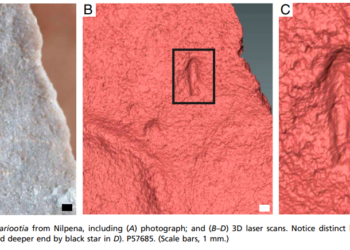The salamander, which lived at the ZSL London Zoo, has been in a museum for 74 years. DNA analysis of confirms that it is indeed a unique species, and probably the largest amphibian that we know of.

The Chinese giant salamander used to roam the rivers of central, southern and eastern China. However, the species is now classified as critically endangered, which makes genetic analysis very challenging (you really don’t want to take samples when every individual is so important).
So instead, researchers used 17 museum specimens for genetic analysis.
They found that what was once considered a single species (Andrias davidianus) is actually three distinct species: Andrias sligoi, Andrias davidianus, and a third species which has yet to be named.
The former of these was actually proposed as a distinct species almost 100 years ago, in 1920 — but the idea was dropped due to insufficient evidence. This recent genetic analysis confirms the ideas of previous naturalists.
The unnamed species is only known from tissue samples and has not been formally described. Its conservation status is unknown, but it is almost certainly critically endangered — or even worse. Even when the three species were considered to be a single group, they were critically endangered; now that the individual species numbers are split even more, things can’t be better.

Unfortunately, salamanders in China have become highly sought-after, in the country’s luxury cuisine black market. Researchers say that this study can help conservationists better understand the evolution of the species, and therefore improve conservation strategies.
“The decline in wild Chinese giant salamander numbers has been catastrophic, mainly due to recent overexploitation for food,” says Professor Samuel Turvey of ZSL’s Institute of Zoology. “We hope that this new understanding of their species diversity has arrived in time to support their successful conservation, but urgent measures are required to protect any viable giant salamander populations that might remain.”
Salamanders are currently moved a lot around China, both for conservation and for usage in farms for the black market. The plans need to consider the existence of multiple separate species and attempt to reduce the risk of competition and genetic hybridisation.
Conservation centers can also play an important role in the species’ conservation. The ZSL recently received four juveniles in September 2016, which had been previously seized by Border Force after an attempt to illegally import them. The general idea with this conservation strategy is to breed the salamanders, then spread them in more conservation centers, and when a stable population is reached, start working on releasing them into the wild. The ZSL and local partners have also conducted extensive wildlife surveys to assess the state of the salamander population, with field surveys carried out at 97 sites over a four-year period between 2013 and 2016.
Melissa Marr, a researcher at the Natural History Museum London explains:
“These findings come at a time where urgent interventions are required to save Chinese giant salamanders in the wild. Our results indicate that tailored conservation measures should be put in place that preserve the genetic integrity of each distinct species. Our research also highlights the central role that The Natural History Museum’s collections can play in the conservation of Critically Endangered species.”
There’s another important aspect to this: one of the analyzed species is probably the world’s largest amphibians. Chinese giant salamanders have been considered the world’s biggest amphibians, reaching almost two meters (6.5 feet) in size. The newly discovered species Andrias sligoi is the largest of the three, and therefore, the largest of the 8,000 amphibian species alive today. It’s the world’s biggest salamander, but it’s potentially going extinct.
The study has been published in the journal Ecology & Evolution.






